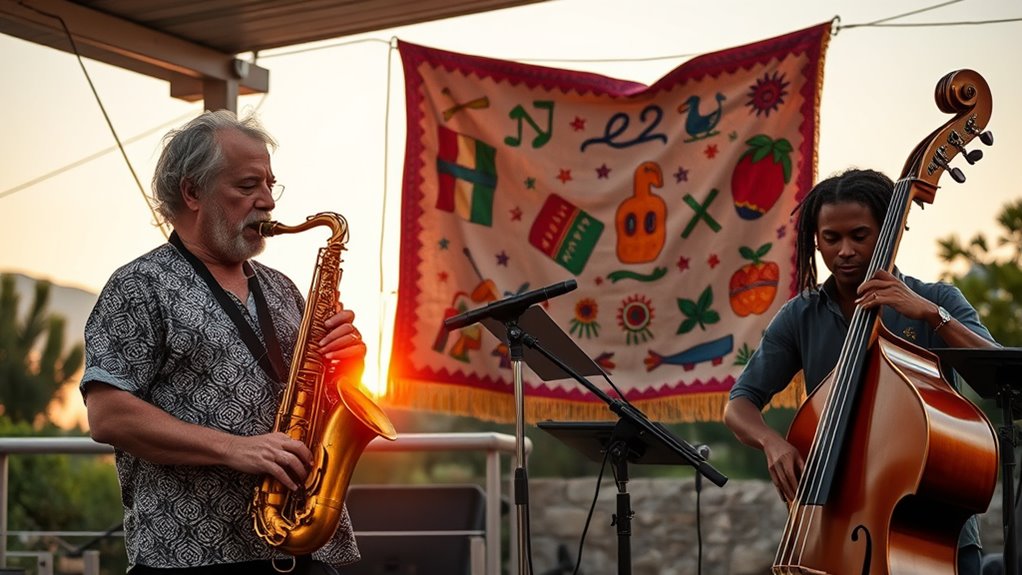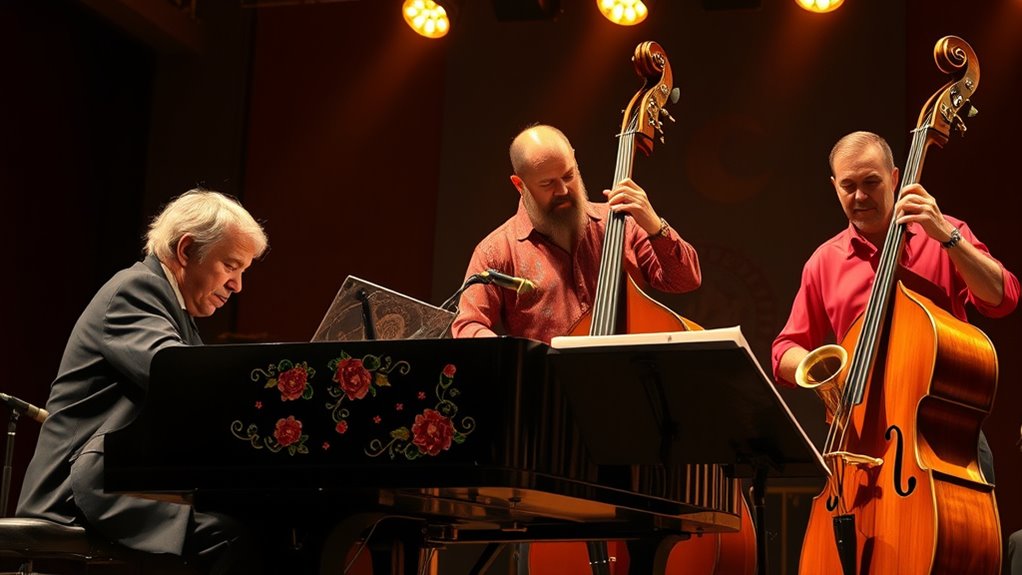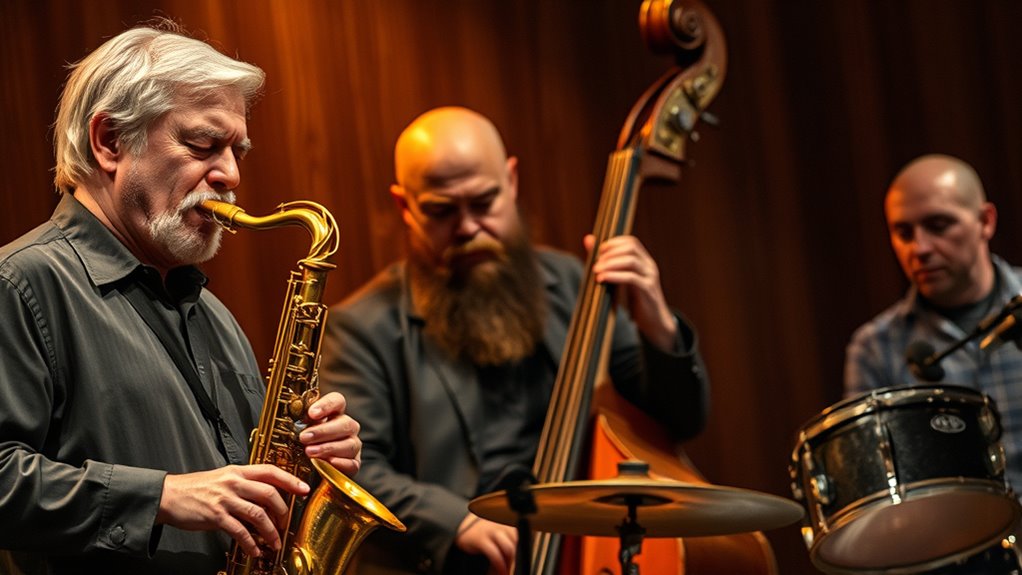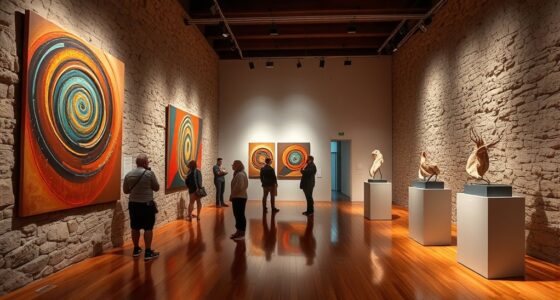If you’re exploring Sardinian jazz, you’ll want to know about Paolo Fresu, a renowned trumpet virtuoso known for blending traditional Mediterranean sounds with modern jazz. Franco D’Andrea, with his innovative piano styles rooted in Sardinian influences, also stands out. The island’s unique scene mixes regional traditions like launeddas and cantu a chiterra with contemporary jazz, often showcased at local festivals. Want to discover how these musicians shape Sardinian and global jazz? Keep exploring to uncover more.
Key Takeaways
- Paolo Fresu is a renowned Sardinian trumpet virtuoso known for blending traditional sounds with jazz improvisation.
- Franco D’Andrea, with Sardinian roots, innovates jazz by integrating regional melodies and experimental techniques.
- Sardinian jazz scene combines traditional instruments like launeddas with modern jazz styles, creating a unique fusion.
- Key festivals like Time in Jazz and Sant’Anna Arresi promote Sardinian jazz internationally, attracting top artists and audiences.
- Sardinian musicians actively participate in global collaborations, influencing jazz with Mediterranean heritage and innovative soundscapes.
Paolo Fresu: Sardinian Trumpet Virtuoso and Cultural Icon

Paolo Fresu, a renowned Sardinian trumpet virtuoso, has become a defining figure in both jazz and his cultural homeland. Born on February 10, 1961, in Berchidda, Sardinia, he started playing trumpet at age 11 in the “Bernardo De Muro” music band. Early influences came from a cassette of Miles Davis in Europe, inspiring his lyrical, expressive style. Turning professional in 1982, he recorded for RAI and impressed jazz legends like Enrico Rava at Siena Summer Jazz Seminars. Fresu’s sound blends jazz with Mediterranean and contemporary influences, often using electronics and vintage effects to craft unique tonal colors. With over eighty albums and collaborations with top artists, he’s celebrated globally. His music reflects Sardinia’s cultural heritage, emphasizing emotion, melody, and poetic expression. He began studying trumpet at age 11 in Bernardo De Muro music band of Berchidda, which laid the foundation for his lifelong dedication to jazz and musical exploration. Additionally, his ability to incorporate musical influences from his homeland into his jazz compositions contributes to his distinctive sound.
Franco D’Andrea: Pioneering Italian Jazz Pianist With Sardinian Roots

Franco D’Andrea’s Sardinian roots influence his rich musical background, blending regional culture with innovative jazz ideas. His work pushes the boundaries of jazz, leaving a lasting legacy of creativity and experimentation. By exploring his career, you see how Sardinian heritage and jazz innovation intertwine to shape his groundbreaking contributions.
Sardinian Cultural Influence
Though born in northern Italy, Franco D’Andrea’s Sardinian roots deeply shape his musical style and identity. His background influences his improvisations, harmonic choices, and rhythmic patterns. You’ll notice Sardinian melodies subtly woven into his jazz, creating a Mediterranean tonal palette that reflects his heritage. His compositions often incorporate traditional folk rhythms and storytelling elements, giving his music a distinct regional flavor. His work with Italian artists blends Sardinian motifs with modern jazz, enriching his sound. Additionally, ongoing AI safety measures in music technology ensure the preservation and authentic expression of regional styles like Sardinian jazz.
Jazz Innovation Legacy
Franco D’Andrea’s innovative approach to jazz has solidified his reputation as one of Italy’s most influential pianists and composers. You’ll notice his early experimentation with rhythmic complexity and melodic abstraction, rooted in African American jazz traditions. His career launched in the 1960s, and he quickly became known for blending free jazz, jazz-rock, and electronic elements, creating unpredictable yet cohesive music. D’Andrea’s ensembles, from trios to large groups, showcase his continuous evolution and openness to diverse textures. His compositions often feature riff-based motifs and thematic improvisation, demanding attentive listening. Over decades, he’s bridged traditional jazz with avant-garde movements, influencing generations of Italian and international musicians. Today, his ongoing projects keep pushing boundaries, preserving jazz’s core while exploring new sonic territories. iCheckMusic tracks and lists can help fans discover and organize his influential works.
The Sardinian Jazz Scene: Traditions and Innovations

The Sardinian jazz scene uniquely blends rich musical traditions with innovative approaches, creating a vibrant and distinctive sound. You’ll find traditional elements like launeddas and cantu a chiterra integrated into modern jazz, adding depth and cultural significance. Sardinian musicians experiment boldly, incorporating ancient instruments, wind sounds, and traditional rhythms into new compositions. This fusion results in a jazz scene that honors its roots while pushing boundaries. Additionally, the use of Natural Language Processing (NLP) techniques helps musicians analyze audience preferences and tailor performances to enhance engagement.
Sardinian Jazz Festivals and International Exposure

Sardinian jazz festivals play an essential role in showcasing the island’s vibrant musical scene to both local and international audiences. The Time in Jazz Festival, held every August since 1988, attracts over 40,000 visitors from across Europe, featuring renowned artists like Paolo Fresu and Enrico Rava. Sant’Anna Arresi Jazz Festival, celebrating its 40th edition in 2025, attracts musicians worldwide, emphasizing Sardinia’s connection to global jazz. Musica sulle Bocche, established in 2001, combines jazz with stunning natural scenery, hosting international stars and emerging talents at sunrise and sunset. Furthermore, Sardinia’s unique blend of scenic landscapes and rich cultural heritage makes it an attractive destination for jazz enthusiasts seeking both music and natural beauty. The island’s international jazz community continues to grow, fostering collaborations and inspiring new generations of musicians. These festivals spread across multiple towns, creating cultural and economic benefits while fostering international exposure for Sardinian artists and broadening the island’s jazz influence beyond local borders.
Fusion of Mediterranean Heritage With Modern Jazz Styles

Mediterranean heritage profoundly influences modern jazz styles in Sardinia, creating a distinctive musical fusion that resonates with both local and international audiences. You’ll notice how Sardinian musicians blend traditional sounds with contemporary jazz, resulting in rich textures and emotional depth. Here are three key aspects:
- Paolo Fresu’s pioneering work combines Mediterranean landscapes and folk vocal textures with jazz improvisation, often collaborating globally and experimenting with genres. His ability to incorporate regional sounds into his jazz compositions exemplifies this fusion. His innovative use of regional musical elements demonstrates how local traditions can shape modern jazz idioms.
- Incorporating folk instruments like launeddas and sulittu brings modal qualities and indigenous rhythms into jazz, enriching the harmonic landscape.
- Vocal traditions such as Corsican choirs and Sardinian singing add unique phrasing and emotional expressiveness, fostering cross-genre dialogue. His extensive collaborations highlight how Sardinian musicians bridge cultural boundaries through innovative jazz.
Influences and Legacy of Sardinian Musicians in the Jazz World

Throughout their careers, Sardinian jazz musicians like Paolo Fresu and Franco D’Andrea have gained international recognition through collaborations, recordings, and festival appearances. Fresu’s distinctive trumpet sound blends Sardinian and Corsican elements, expanding regional influence globally. D’Andrea connects Sardinian jazz with American legends like Max Roach, fostering cross-cultural dialogue. Their participation in European and American festivals elevates Sardinian jazz on the world stage, inspiring new generations. Their work in education, through conservatories and mentorship, guarantees Sardinian jazz’s ongoing legacy. Instrumentally, they innovate by merging traditional melodies with modern improvisation, pushing jazz boundaries. This table highlights their core contributions:
| Cultural Influence | International Collaborations | Educational Impact |
|---|---|---|
| Regional sounds | Cross-genre projects | Mentorship programs |
| Fusion techniques | Festival appearances | Jazz research centers |
| Mediterranean heritage | Recordings with legends | Institutional legacy |
Additionally, their influence has helped preserve Sardinian musical traditions while adapting them to contemporary jazz contexts, ensuring a vibrant cultural dialogue.
Frequently Asked Questions
How Has Sardinian Culture Uniquely Shaped Its Jazz Musicians’ Styles?
You can see how Sardinian culture shapes its jazz musicians’ styles through its rich folk traditions, regional dialects, and island isolation. These elements inspire unique melodies and storytelling in their music, blending traditional sounds with modern jazz. Local festivals and community support encourage experimentation. As a result, you’ll notice a distinctive fusion of Sardinian identity, blending folk, classical, and jazz influences into innovative, authentic sounds that reflect the island’s cultural diversity.
What Are Some Lesser-Known Sardinian Jazz Artists Gaining International Recognition?
Imagine a seed sprouting quietly in a vibrant garden—that’s how lesser-known Sardinian jazz artists are gaining recognition. Daniela Pes, with her fusion of jazz, electronic, and world sounds, stands out for her innovative vocals. Alongside her, emerging instrumentalists and bands blend traditional Sardinian roots with modern jazz, performing at local festivals that act as launchpads. Their unique styles are slowly blooming on the international stage, capturing the world’s attention.
How Do Sardinian Jazz Musicians Incorporate Traditional Folk Elements Into Their Compositions?
You see, Sardinian jazz musicians blend traditional folk elements by integrating instruments like launeddas, cane flutes, and tumbarinos into their compositions, creating rich textures that honor heritage. They adapt Sardinian vocal styles like cantu a tenore with jazz improvisation, maintaining dialect lyrics and folk melodies. Rhythms from Sardinian dances and modal scales influence their harmonies, resulting in a unique fusion where folk and jazz seamlessly intertwine, celebrating cultural roots while exploring new musical territories.
What Role Do Sardinian Jazz Festivals Play in Promoting Local Talent?
Imagine a vibrant tapestry where Sardinian jazz festivals are the loom, weaving local talent into a global fabric. You see, these festivals spotlight your musicians alongside international stars, giving them a platform to shine brightly. With diverse venues and free concerts, they break down barriers, offering exposure, networking, and growth opportunities. Through cultural blending and community events, they nurture your local jazz scene, making it thrive and resonate worldwide.
How Has Sardinia Influenced the Broader European Jazz Scene Historically?
You see, Sardinia has shaped European jazz historically by blending its rich folk traditions with jazz, creating a unique sound. Its use of polyphonic vocals and traditional percussion introduced fresh textures that enriched European jazz compositions. The island’s musicians, including prominent figures, collaborated across borders, spreading Sardinian influences throughout Europe. This cultural hybridization fostered innovation and diversity, making Sardinian jazz a crucial part of European jazz’s evolution.
Conclusion
Discover the dazzling diversity of Sardinian jazz, where tradition and innovation intertwine. From fiery fusions to formidable festivals, Sardinian musicians like Fresu and D’Andrea demonstrate daring dedication and dynamic talent. Immerse yourself in their daring stories and discover how they shape the global jazz scene with passion and precision. Sardinian soundscapes serve as a symphony of soul, showcasing a stunning, soulful saga of skills, spirit, and style that continues to inspire.









